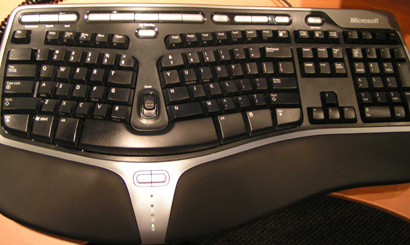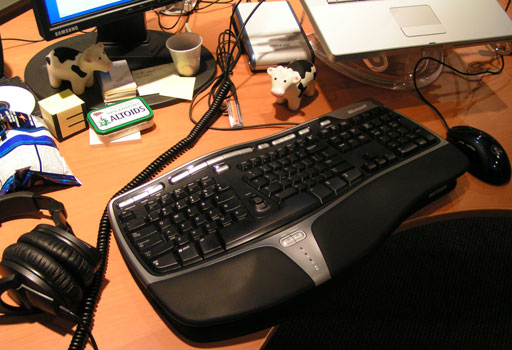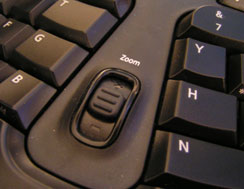Microsoft Natural Ergonomic Keyboard 4000
One of the first steps I took to overcome my RSI was to switch to a natural keyboard.
There are many goofy and expensive "ergonomic" keyboards, but RSI experts can't agree on their effectiveness. The consensus is that they might help, but probably not much without other work-environment changes such as proper posture and the correct seating position.
I didn't want to spend $300-1000 on something with a huge learning curve that "might" help. Instead, I decided to try the $50 Microsoft Natural Ergonomic Keyboard 4000.

It has the vertical split common on ergonomic keyboards, and the main keys are angled so your wrists can hold your hands straight forward instead of at the slight outward angle needed to type on a straight row of keys. (The official term for the normal bad angle is "ulnar deviation".)
The most noticeable design departure from normal keyboards is the "negative tilt". Your wrists should never need to tilt your hands upward to type - this is why you should not prop up keyboards with those little stand-legs on the back. (I bet you didn't know that unless you paid attention to the last article. Nobody ever knows that.)
This keyboard has those annoying stand-legs if you choose to use them, but it comes with a large plastic stand clipped to the front edge of the keyboard so it tilts slightly back away from you. Since you should be sitting at a height that positions your elbows at a slightly obtuse angle (did you forget what that means?), this should allow your hands to align naturally with the straight line of your forearms.

You can detach the front stand, but without it, the keyboard has a moderate forward tilt (even without the rear stand-legs) that negates most of the advantages it provides. If you get this keyboard, plan to use the front stand.
In reality, most chairs are too low and most desks are too high to allow this proper seating position. If you can't sit high enough above the desk to achieve this angle with your arms and you need to reach up to they keyboard, this will actually make your position worse because your wrists will be angled sharply downward. But needing to reach up for the keyboard is always bad, and if that's the way you sit, you should get a new desk and chair anyway.
Notice that in the picture above, the keyboard is sitting on the front edge of the desk. This is important, especially if you're short or have short forearms: if it's too far back, your upper arms will have an unnecessary burden to keep your hands so far forward, so you'll probably slouch and rest your arms or wrists on the desk. (Remember, that's bad!)
Also, notice the scale of the other items in the picture. This keyboard is big. You could probably use it as a lifeboat in an emergency. If you don't have a lot of space for a keyboard, you should probably look elsewhere or get a new desk. I wouldn't recommend putting it on a keyboard tray unless you have at least a 5-inch height gap between the tray and the desk above it.
Once you've achieved the proper positioning, using the keyboard is comfortable and convenient. The keys require only a light touch to depress, yet provide normal feedback and aren't mushy. They're not laptop-style scissor keys, but they're only about two-thirds the height of regular desktop keys. They aren't as springy (or loud) as an old clicky keyboard, but most people are fine with that. And because this uses a standard key layout, using other "normal" keyboards periodically doesn't feel incredibly foreign or require you to re-learn how to type on them.
The software is Mac-friendly, allowing you to assign actions or AppleScripts to the special buttons, and swap the Windows and Alt keys (so Alt is the Mac's Command key). Below the spacebar are "Back" and "Forward" keys that map easily to whatever you want. The Windows software is similar.

I also would have liked a built-in USB hub. Come on, Microsoft, you're the ones who started doing that almost a decade ago. Why did you stop? I'd be willing to pay an extra $20 for two or four USB ports, even if using them required an external power adaptor.
The big question: has this keyboard helped my RSI? (Oh yeah, I knew I bought it for a reason.)
Maybe.
It's hard to scientifically test this. Proper testing would keep all other variables constant, but if you're buying this keyboard, you're making a conscious effort to improve your working conditions to reduce RSI. I bought this keyboard, but I also got a new desk and chair, I'm sitting with much better posture, and I'm using my home computer less than before.
My symptoms have improved, but I can't definitively say that this keyboard has had much to do with it. I don't think it's made anything worse...
Either way, it's a great keyboard. Even if it's not significantly reducing RSI, a great keyboard for $50 isn't a bad deal at all. I own two (home and work), and two of my coworkers liked mine enough to get their own. If you have the proper physical accommodations for it and you use your computer for more than a few hours per day, I strongly recommend it.